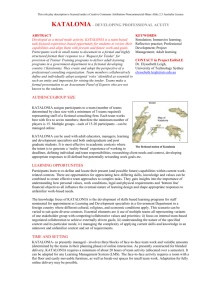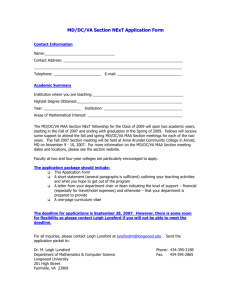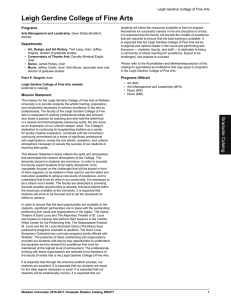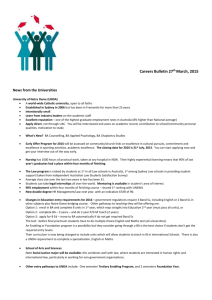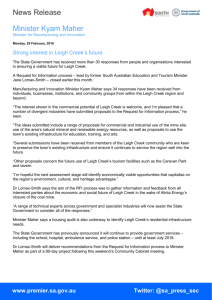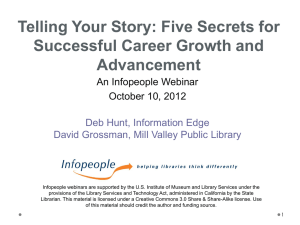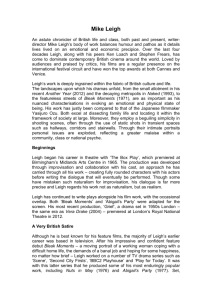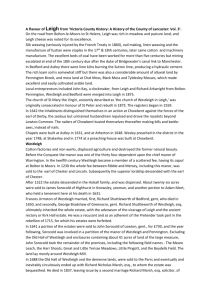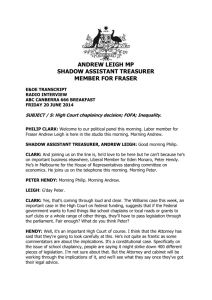OLRP_RiftRaft
advertisement
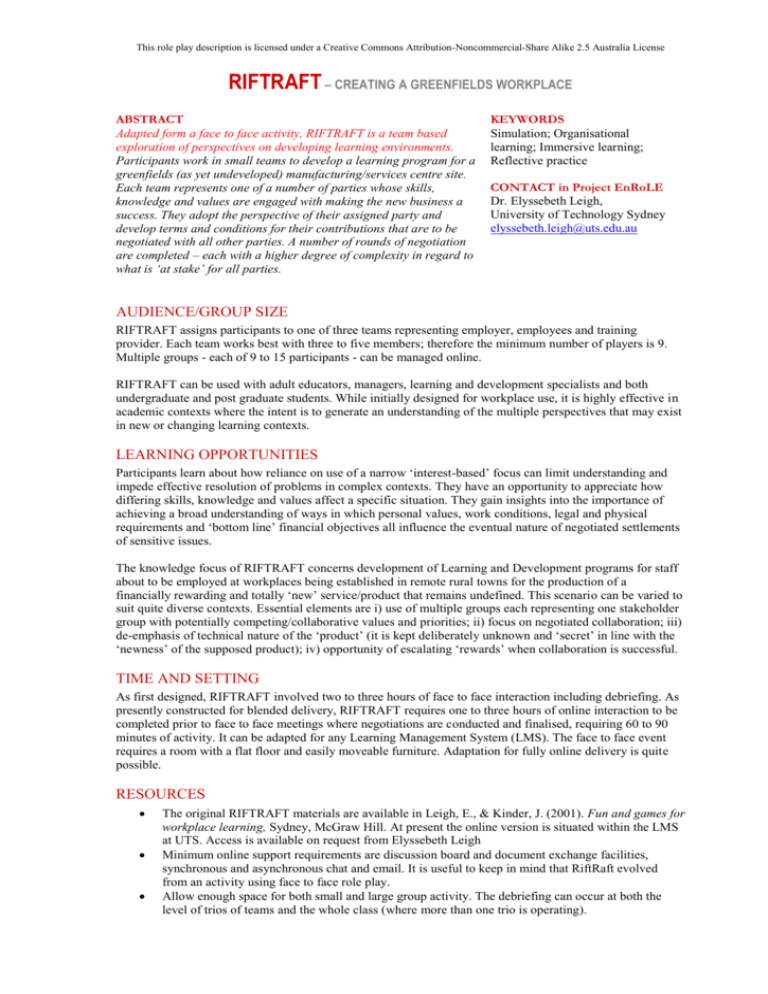
This role play description is licensed under a Creative Commons Attribution-Noncommercial-Share Alike 2.5 Australia License RIFTRAFT – CREATING A GREENFIELDS WORKPLACE ABSTRACT Adapted form a face to face activity, RIFTRAFT is a team based exploration of perspectives on developing learning environments. Participants work in small teams to develop a learning program for a greenfields (as yet undeveloped) manufacturing/services centre site. Each team represents one of a number of parties whose skills, knowledge and values are engaged with making the new business a success. They adopt the perspective of their assigned party and develop terms and conditions for their contributions that are to be negotiated with all other parties. A number of rounds of negotiation are completed – each with a higher degree of complexity in regard to what is ‘at stake’ for all parties. KEYWORDS Simulation; Organisational learning; Immersive learning; Reflective practice CONTACT in Project EnRoLE Dr. Elyssebeth Leigh, University of Technology Sydney elyssebeth.leigh@uts.edu.au AUDIENCE/GROUP SIZE RIFTRAFT assigns participants to one of three teams representing employer, employees and training provider. Each team works best with three to five members; therefore the minimum number of players is 9. Multiple groups - each of 9 to 15 participants - can be managed online. RIFTRAFT can be used with adult educators, managers, learning and development specialists and both undergraduate and post graduate students. While initially designed for workplace use, it is highly effective in academic contexts where the intent is to generate an understanding of the multiple perspectives that may exist in new or changing learning contexts. LEARNING OPPORTUNITIES Participants learn about how reliance on use of a narrow ‘interest-based’ focus can limit understanding and impede effective resolution of problems in complex contexts. They have an opportunity to appreciate how differing skills, knowledge and values affect a specific situation. They gain insights into the importance of achieving a broad understanding of ways in which personal values, work conditions, legal and physical requirements and ‘bottom line’ financial objectives all influence the eventual nature of negotiated settlements of sensitive issues. The knowledge focus of RIFTRAFT concerns development of Learning and Development programs for staff about to be employed at workplaces being established in remote rural towns for the production of a financially rewarding and totally ‘new’ service/product that remains undefined. This scenario can be varied to suit quite diverse contexts. Essential elements are i) use of multiple groups each representing one stakeholder group with potentially competing/collaborative values and priorities; ii) focus on negotiated collaboration; iii) de-emphasis of technical nature of the ‘product’ (it is kept deliberately unknown and ‘secret’ in line with the ‘newness’ of the supposed product); iv) opportunity of escalating ‘rewards’ when collaboration is successful. TIME AND SETTING As first designed, RIFTRAFT involved two to three hours of face to face interaction including debriefing. As presently constructed for blended delivery, RIFTRAFT requires one to three hours of online interaction to be completed prior to face to face meetings where negotiations are conducted and finalised, requiring 60 to 90 minutes of activity. It can be adapted for any Learning Management System (LMS). The face to face event requires a room with a flat floor and easily moveable furniture. Adaptation for fully online delivery is quite possible. RESOURCES The original RIFTRAFT materials are available in Leigh, E., & Kinder, J. (2001). Fun and games for workplace learning, Sydney, McGraw Hill. At present the online version is situated within the LMS at UTS. Access is available on request from Elyssebeth Leigh Minimum online support requirements are discussion board and document exchange facilities, synchronous and asynchronous chat and email. It is useful to keep in mind that RiftRaft evolved from an activity using face to face role play. Allow enough space for both small and large group activity. The debriefing can occur at both the level of trios of teams and the whole class (where more than one trio is operating). LEARNING ACTIVITIES The resource kit contains a set of contextualising materials - including a press release outlining the ‘new product’ and its particular needs; role descriptors; process guidelines. These guide the teams as they adopt the ‘persona’ of the groups they represent. The first task is to achieve agreement about the likely range of values, skills interests and beliefs – as well as goals and minimum acceptable outcomes – of the hypothetical stakeholders in the events that are about to unfold. Once these are fairly well established representatives of each stakeholder group meet to exchange basic demands and expectations. This meeting usually reveals gaps in each group’s understanding of the others’ positions, creating opportunities for emerging awareness of possible need to reconsider current stances; the need to re-structure positions; to take advantage of what was learnt at this meeting. The meeting can be conducted via a chat room or Skype. A series of further meetings then refine understanding and expression of small and whole group stances on stated goals and seek progress towards creating a document outlining a mutually agreed stance for use in justifying external funding that is linked to evidence of such agreement. DEBRIEFING RIFTRAFT creates a fairly stressful environment in which the external goal of achieving funding is counterpoised to the values engaged by involvement with specific interest groups. Debriefing, a critically important part of the learning, is usually conducted around three themes as follows: a) Local needs – e.g. what is the impact of closely held personal values on the likelihood of achieving broader goals which may be, or appear to be, in conflict with those values b) Communication among interest groups: e.g. What factors influence such groupings? Which strategies best help – or most hinder – development of mutual interests? How important is the expression (or concealment) of strongly held values during negotiations? c) Impact of external forces – e.g. how much does a group need to know, to make informed decisions when external forces have strong potential impact on future prospects? What are the necessary steps to achieve general agreement among competing interest groups? FACILITATOR EXPERIENCE The facilitator must remain aloof from the process – and avoid answering questions about the mysterious RIFTRAFT. However, groups may have quite unequal grasps of the complexity of their task and the facilitator may need to ask (but never answer) questions whose answers would suggest appropriate directions for discussion. Such questions are used sparingly and only when it is clear that a group has become fixated on an issue of trivial consequence or likely to become a mis-direction. A good eye for timing and a strong sense of equity is also important. Knowledge of the subject content will be important – more to assess the viability of proposed decisions and funding requests. In this regard RIFTRAFT can be adjusted to address a number of content areas. REUSABILITY The role play can be customised to suit a variety of contexts in which multiple parties must learn to negotiate agreement among objective, or emotionally charged, differences in perspectives and desired goals. REFERENCES Leigh, E. (2003). A practitioner researcher perspective on facilitating an open, infinite, chaordic simulation. http://adt.lib.uts.edu.au/public/adt-NTSM20040831.172032/ Ed D, University of Technology, Sydney Leigh, E., & Kinder, J. (2001). Fun and games for workplace learning, Sydney, McGraw Hill.
